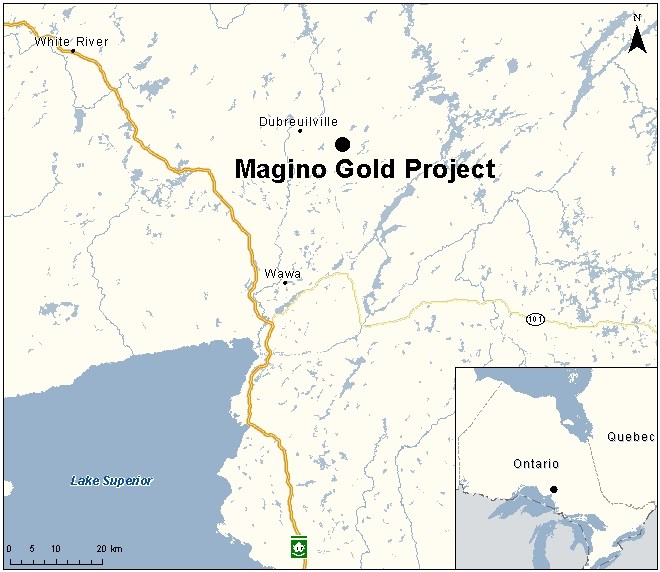The emerging Wawa gold camp may be adding another mine.
A positive feasibility study released by Toronto’s Argonaut Gold expects its Magino gold project in northeastern Ontario to produce nearly two million ounces of gold over the course of a 17-year mine life.
The company outlined the economics and production for an open-pit mine when it released a feasibility study for the advanced stage gold project, Nov. 8.
The 2,204-hectare property, a former underground gold mine, is located 40 kilometres northeast of Wawa and 14 kilometres southeast of Dubreuilville. The project is close to Richmont’s Island Gold mine.
Plans call for the mine to average 150,000 ounces of gold for the first five years of production. The Magino deposit has a measured and indicated gold resource of 4.1-million ounces.
The company said the environmental permitting process is underway after filing its impact paperwork to the federal and provincial governments last January.
Argonaut provided no date on when construction of the pit will start but the company expects to receive final environmental assessment and mine closure plan approvals sometime during 2018.
This will allow the company to apply for and receive permits to begin construction of all major infrastructure.
Magino is being designed as a scalable operation that can expand should the project’s economics improve or should a joint-venture partner happen to come along.
Compared to the pre-feasibility study Argonaut put out in January 2016, the best option at this point is to downscale the processing operation from 30,000 tonnes per day to 10,000 tonnes.
The processing plant is designed with an average gold head grade of 1.25 g/t to achieve an overall gold recovery of 92 per cent.
In a news release, company president-CEO Pete Dougherty considers Magino a “strategic, long-life asset” in their portfolio of operations and properties.
“The size, location, economics, and expandability of Magino give Argonaut significant flexibility to explore options around the project on its own or with partners.”
It’ll cost US$293 million to construct the pit over 24 months. The all-in sustaining cost is $711 million.
The open-pit operation will involve a fleet of front-end shovels and a loader, and haul trucks. The fleet will be supplemented by drills, graders, track and rubber-tire dozers.
“We are fortunate that the Magino deposit is an ore body that lends itself to scalability,” said Argonaut COO Bill Zisch.
“Having the ability to right-size the project, in terms of initial capital for our size of company and current market conditions, while maintaining optionality for the future is a significant benefit to the organization.
“We will continue through the environmental assessment process and permitting and then gauge market conditions and all available options for Magino to best unlock value for our shareholders.”
The company reports engagement with Indigenous communities and municipalities is ongoing.
Agreements have been signed with the Missanabie Cree and the Red Sky Metis Independent Nation.
Argonaut Gold has several producing mines and exploration properties across North America, including its El Castillo in Durango and La Colorado mine in Sonora, Mexico.




